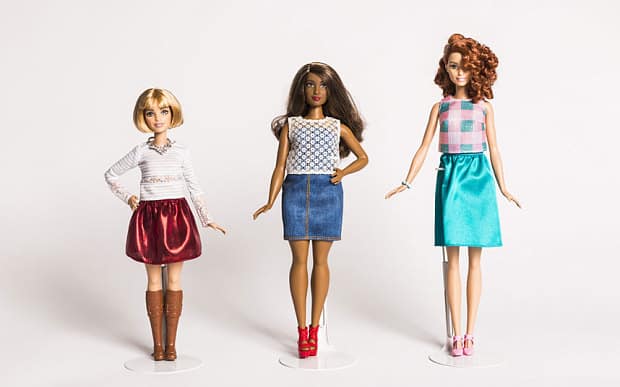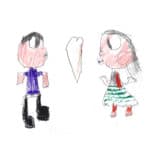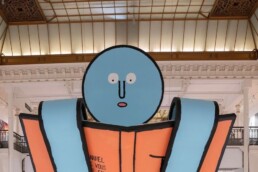Until fairly recently due to sanctions imposed by my eldest daughter, Barbie had never set foot through our front door. Now times have changed there is a second legislator in the house, a sparkly younger sister who seems to be collecting a girl gang that could rival that of Taylor Swift, all fully equipped with blown up lips and dressed in clothing surely made for a smaller doll.
None of these beauties were purchased by myself, some are given as presents and some handed down by friends and family. It’s a difficult one, of course she loves them, with their big eyelashes, blue eyeshadow and heals. Apparently, we are predisposed to like symmetrical faces, big eyes and small noses, but as a parent I want my girls to be exposed to positive body images, to embrace differences/diversity and not to aspire to unachievable aesthetics. The good news is that things might be changing.

This year an iconic blue-eyed blond with implausible proportions received a long awaited makeover. A new range of the famous Barbie doll has been released including three optional body shapes – petite, tall and curvy – as well as seven different skin tones and 24 hair styles. Toy company Mattel instigated the change to better reflect the diversity of the product’s audience and appeal to the “millennial moms” – a group (according to Mattel) driven by social justice and attracted to brands with purpose and values. This is the brands biggest update since Barbie launched in 1959, and a huge investment so Mattel must believe the value in representing a more realistic female figure whilst of course broadening its appeal. Consumers reaction to Barbies new figure: Guardian video here.
In some cases parents are taking the matter into their own hands, with Tasmanian mother Sonia Singh and UK mother Emma Cayley rolling up their sleeves and getting involved. Both mums living on different sides of the world independently became increasingly concerned about available dolls on the market, questioning the unrealistic standards of female beauty and unhealthy body image, especially it seems the Bratz doll. Their solution, a make under, remove the make-up, add freckles, reduce the lips, plait the hair and redress and Voila, a new demure looking doll. Some say this is disempowering girls from expressing their individuality, to dress they way they want, and to experiment. That by doing this they are conforming to society’s conservative view of women.
So a little experiment… I asked my girls along with their two cousins to draw Barbie, no guides or references. This is what they came up with:






This market is huge business, for each girl knocking back barbie there are many more putting together their girl gang. It’s encouraging that companies like Mattel are reacting to their audience by taking steps to create a more diverse range, although its significance is put into perspective when you look across their range of dolls. It would be nice if this new found sense of responsibility was adopted by more companies and doll lines, I’m saying nothing of Bratz.
In the end, Barbie still resides at my home, going on extreme adventures, having multiple haircuts and not to mention countless marriages, but her exploits in life and the love my four year old daughter bestows means she doesn’t quite resemble the doll that arrived at the door. No make under required.
Feature image installation by Belgian artist Annette Thas @annettethasartist
Katie Kendrick
Katie is a specialist in kids’ fashion and lifestyle, editor, consultant, content creator, and owner of Pirouette - a leading resource to the industry.
With a keen interest in both the business and creative aspects of the industry Katie has interviewed buyers, agents, stylists, designers, influencers, covered runway shows, produced trade show reports and curates thought provoking and engaging exhibitions.
She is passionate about good design, creativity and brands that manage to combine this with their environmental responsibility.
Subscribe to Pirouette's monthly Newsletter.
You might also like
February 29, 2024
Jean Jullien’s ‘Paper People’ at Le Bon Marche Rive Gauche, Paris
If you're in Paris make sure to pop into Le Bon Marche, Rive Gauche - there you will encounter two gigantic blue paper people created by Jean Jullien. Art set in a retail space ensuring an enhanced…
October 7, 2022
Home grown remedies: Head lice
Rosemary & lavender nit treatment.A natural formula for effective nit treatment free from organophosphates. Easily found ingredients, simple to make and use. Great for getting rid of both the…
September 18, 2022
Growing up with cancer – part 2 of 2
Childhood cancer awareness month
A personal story by Beau Johnston.
September 15, 2022
Growing up with cancer – part 1 of 2
Childhood cancer awareness month
A personal story by Beau Johnston.
August 26, 2022
Home grown remedies: Hot flushes
Raspberry leaf and sage teaRaspberry leaves are well known for balancing female hormones, whilst sage is good for reducing sweating. Combine the two and we have a refreshing drink that can help…
October 6, 2021
Pirouette kicks back into action
After being hacked & disabled we're back to bringing the whats what in Kid's fashion & lifestyle! Pirouette has been a little quiet for a while. In part at least because I've been working for…
August 27, 2020
Little Creative Factory AW20 collection ‘Unexpected Poetry’ launches today!
It's been a year since founder and designer of Little Creative Factory made the big move to the even bigger Apple with her lovely family. What a year it has been, there's no stopping this family…
March 26, 2020
Living with Coronavirus
It's worse than we know in the UK... I’m writing this sat upright in bed feeling like a sumo wrestler is parked on my chest, just short breaths in and out. I had been feeling a little unwell - a dry…
March 3, 2020
How to Talk to Kids About Coronavirus? – NY Times Article
So how do you talk to kids about coronavirus? Well a NY Times parenting article by journalist Jessica Grose could help keep your anxiety in check with some helpful advice, tools and links. Go to…














